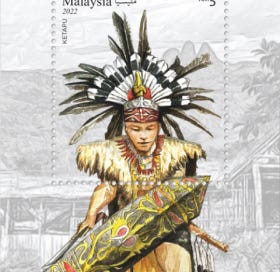Pos Malaysia released a series on Men's Headgear. This special stamp issue showcases 5 different traditional headgears of various cultures across Malaysia1:
Tanjak of Malay men (70sen ~ USD 0.16)
Tempok of the Orang Asli men (70sen ~ USD 0.16)
Siga of the Kadazan men (80sen ~ USD 0.18)
Lavung Tepo/Dok of the Orang Ulu men (80sen ~ USD 0.18)
Ketapu of the Iban men (RM5 ~ USD 1.12) ← our topic today
Malaysia is a country of many cultures, religions and ethnic backgrounds. Specifically, the Ibans, formerly known as the Sea Dayaks, are a branch of the Dayak peoples on the island of Borneo.







Ketapu in Iban means hat. There are different variants or types of ketapu depending on how it is made and what it is made out of.2 Typically, it is hand woven out of rattan or sliced bamboo with several pointed tops and decorated with long hornbill feathers or plumes.

Hornbills are important cultural symbols for the Dayak people, representing the spirit of God. Hornbill elements are also incorporated into the Dayak people’s arts, dances, carvings, and ceremonial dresses.3
If you’d like to hear the calls of the Rhinoceros Hornbill, xeno-canto, a website that shares bird sounds from around the world has recordings. Here’s one where you can clearly make out the hok or hak sounds they are making.4 Note that males utter deep, forceful hok calls while females’ have a higher hak.5
The term “a feather in your cap” is an English idiom derived from the general custom of a warrior adding a new feather to their headgear for every enemy slain.6 The title of this post is an apt variant of that phrase. Ibans were renowned for practicing headhunting and territorial migration, and had a fearsome reputation as a strong and successfuly warring tribe. Since the arrival for Europeans and the subsequent colonisation of the area, headhunting gradually faded out of practice.
Speaking of headhunting, I mean headgear, I find it pretty amusing that the hornbills themselves look like they wear something on their heads. That protrusion is known as a casque and this casque plays an important role as a "resonating chamber" to amplify the nasal sounds made by the birds. The casque is very light, being made up of thin, hollow cells supported by tiny, hollow bones.7

Lastly, I wanted to end this piece on a wholesome note. 3 years ago, I remember visiting the Jurong Bird Park in Singapore. They had a Great Pied Hornbill that had to have his casque amputated because it had cancer. He was later given a 3D-printed prosthetic casque! Yay for technology! Do yourself a favor and please watch the videos here to see how they helped Jary the hornbill: https://www.mandai.com/en/the-wild-scoop/jary-the-great-hornbill.html (warning: bird blood)

If you like this post, please feel free to share it with your friends and family or leave a comment with your thoughts.
If you have yet to subscribe to the newsletter, please consider doing so.
“Hiasan Kepala Lelaki Folder Set.” Pos Malaysia, www.pos.com.my/hiasan-kepala-lelaki-folder-set.html. Accessed 21 Aug. 2022.
Janggang. “IBAN TRADITIONAL CLOTHING AND ATTIRE.” Iban Customs & Traditions, 15 Aug. 2009, ibancustoms.wordpress.com/iban-traditional-clothing-and-attire.
“The Magnificent Hornbills of Sarawak.” Borneo Post Online, 12 July 2015, www.theborneopost.com/2015/07/12/the-magnificent-hornbills-of-sarawak.
Marc Anderson, XC173912. Accessible at www.xeno-canto.org/173912.
“The Magnificent Hornbills of Sarawak.” Borneo Post Online, 12 July 2015, www.theborneopost.com/2015/07/12/the-magnificent-hornbills-of-sarawak.
“A Feather in Your Cap.” Wikipedia, en.wikipedia.org/wiki/A_feather_in_your_cap. Accessed 21 Aug. 2022.
“Great Hornbill.” Saint Louis Zoo, www.stlzoo.org/animals/abouttheanimals/birds/kingfishershornbillsbeeeat/greathornbi01. Accessed 21 Aug. 2022.


